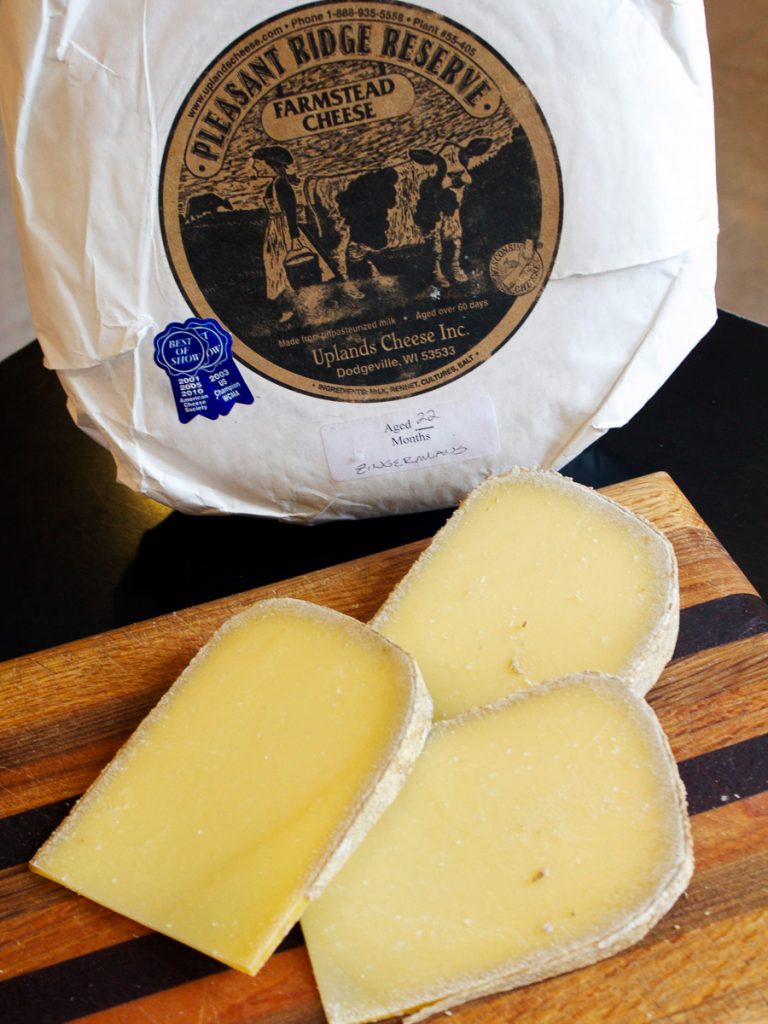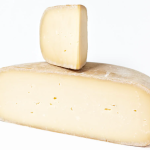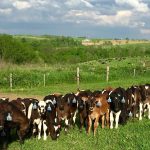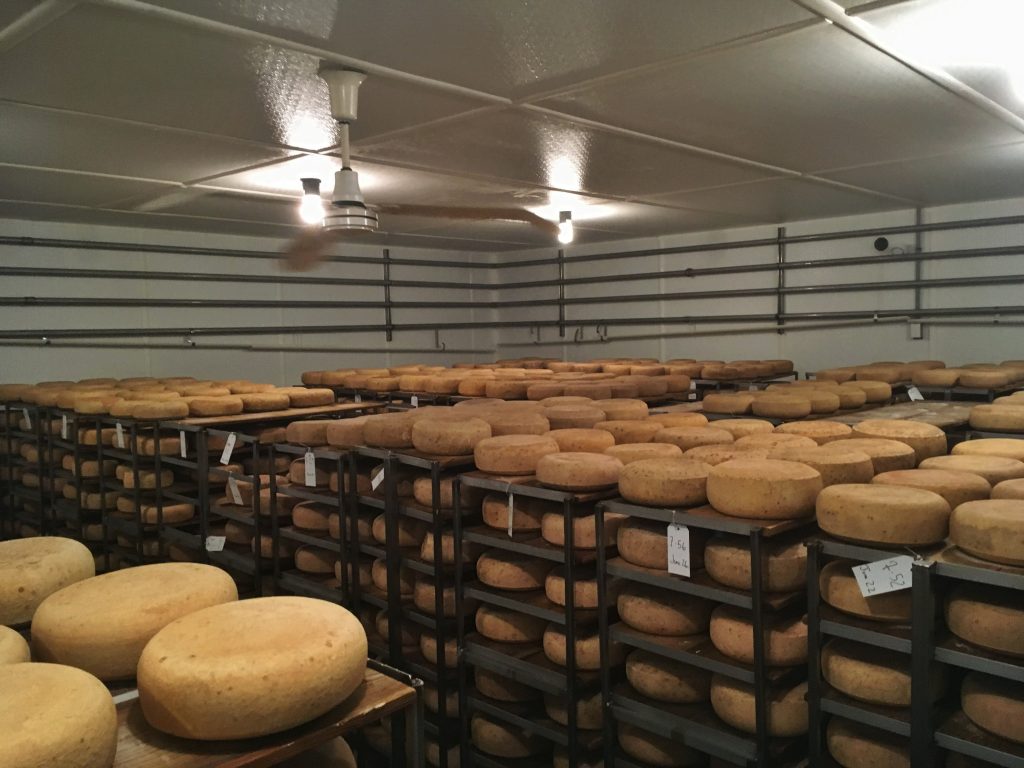
We’ve shared with you a bit more about Uplands Cheese’s story, how their herd of 200 cows is pasture-raised and milked seasonally and how they cross-bred nine different types of cows in an effort to breed cows that thrive on their farm and produce ideal milk for making their cheese. Now, we want to dive a little deeper into their signature cheese, Pleasant Ridge Reserve, with the help of some of our favorite big cheeses: Andy Hatch, Uplands Cheese owner; Trevor Murray, Deli Specialty Foods Manager; and Sean Hartwig, former Deli Specialty Foods Manager. We learned a lot from them during one of their annual batch tasting sessions at the Deli (you can join us for the next one, read on!) and the information was too grate not to share.
What Makes Uplands Cheese So Moo-velous
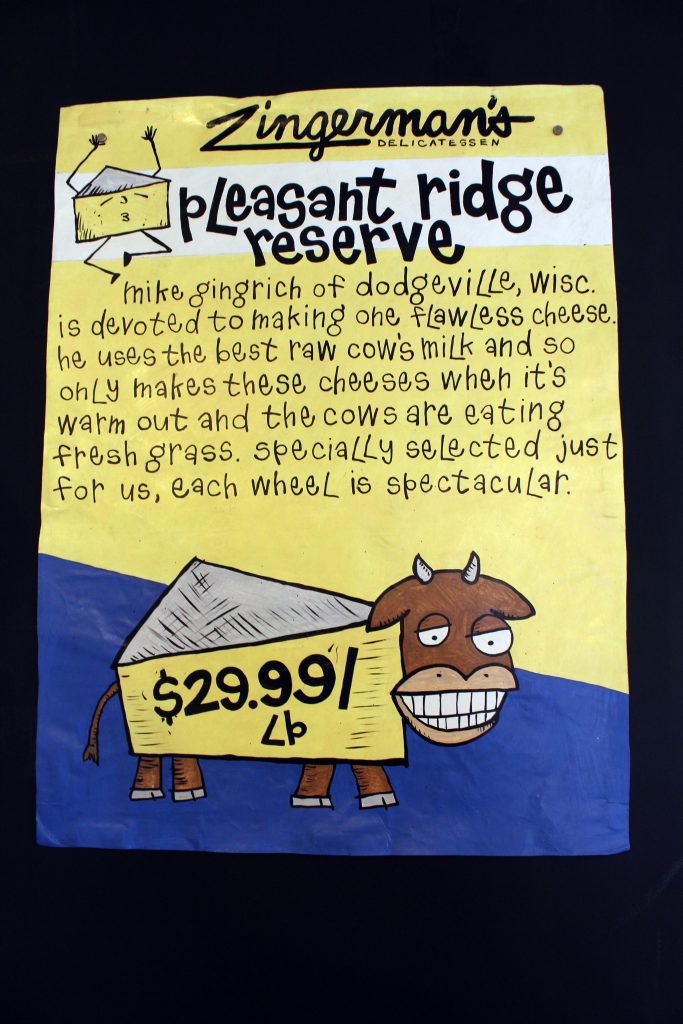
Pleasant Ridge Reserve is in a class of its own (a multi-time award-winning class, that is), and there’s a lot that goes into what makes it so special:
Style
Pleasant Ridge Reserve is an alpine-style cheese. But what does that mean? As Andy explains:
And you know the classic versions of alpine-style cheeses are Gruyere, Beaufort, Comté… So “alpine” is sort of like saying a beer is a lager, it just kind of identifies the techniques used to make the cheese. We gave it our own name because the point is to try to make a cheese that tastes like our farm, so we didn’t want to call it Beaufort, we weren’t trying to copy an old-world cheese. But that is the inspiration, not only because it’s made with summer grass-fed milk just like the classic alp cheeses, but also because the techniques are borrowed from those traditions.
Milk
Their cows produce about five gallons of milk per day (about half the amount of milk that a big modern cow kept in a barn would). Luckily, as we’ve already mentioned, they aren’t focused on volume. As Andy says, “We’re really after flavor and so we farm in a way that doesn’t give as much yield but gives a lot more flavor.”
Trevor went and worked with Andy, making cheese for a whole year, and experienced firsthand the impact of using exclusively raw milk, as Uplands Cheese does, saying:
The cheese’s cost is reflected in the flavor, sure, which wouldn’t be possible without unpasteurized milk; but there’s a lot of extra labor and expense wrapped up in the cleaning and testing required to keep raw milk safe. Scrupulous cleanliness is essential and Uplands cuts zero corners.
Aging Process
Most of the labor associated with cheesemaking happens in the caves, the cheese-aging rooms. As Trevor says, “Each of them is controlled to provide cheeses with the environmental conditions they need at certain points in their lives.” What are the environmental conditions in question? Andy goes on to explain:
Temperature and humidity are everything, nearly everything. Cheesemaking is fermentation, of course, and so it’s the microbes that are really doing the work. Your job as a cheesemaker and as an affineur, someone who ages cheese, your job really is to just manipulate the conditions that make the microbes behave in different ways. And so the key conditions, at least externally outside of the cheese, are temperature and humidity. Inside the cheese, you also need to play with moisture, acidity, and salt, but cheese like this is made in a very hot room and you want that heat to promote fermentation. The bugs, the microbes used to ferment a cheese like this, like hot temperature, they’re thermophiles, they like the heat.
Each wheel of cheese is handled once or more per day for its first two weeks, then handled at least once per week for the rest of its time in the caves. Given that they age from a year up to a year and a half, that’s a lot of time, attention, and TLC.
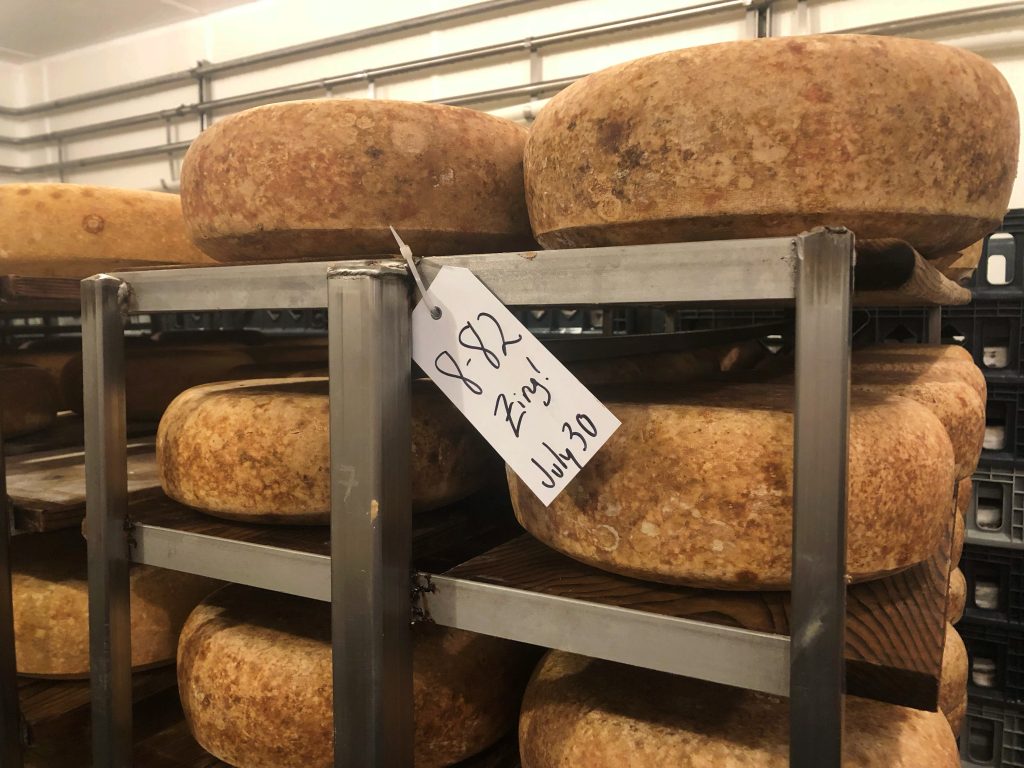
Texture & Flavor
There’s about 32 or 33% fat in Pleasant Ridge Reserve, which is higher than a lot of classic old-world aged cheeses, giving it a fairly fudgy texture and a rich, fatty mouthfeel. Andy elaborates on the impact of fat in cheeses:
As you age a cheese — cheese is basically a clump of fat protein and the ripening of cheese is a matter of breaking down those fats and proteins into fatty acids and amino acids, things that become flavor and aroma, and fats are often the first things to break down in the cheese. But they can also send a cheese kind of sideways as it ages out longer, texture-wise and flavor-wise, and that is why a lot of long-aged cheese is made with skimmed milk, so Parmigiano Reggiano, you skim the milk, you want less fat. We kind of walk that line and we don’t skim our milk, we like to see more fat in it than you might find in an old-world Gruyere and Comté. I think there’s a lot of flavor in fat, particularly off grass-fed cows, that buttery, really rich fat flavorful fat, and I also like the mouthfeel. We don’t run into the kind of rancidity or the fat problems you see with long-aged other cheeses simply because we’re not aging our cheese that long.
Fat isn’t the only factor that can impact texture and flavor, as Andy explains:
We want to make something that tastes like our farm, like something that nobody else can replicate, so when you rely on your pasture, and on the weather, and on your single herd of cows, you feel every bump in the road that will manifest in flavor and texture. … the moisture in the cheese will change day to day based on where the cows are grazing. Higher-fat cheeses will hold more moisture and will be a little spongy or softer, fudgier. Lower-fat cheeses tend to be lower moisture and a tighter body, and we would tend to age those longer. The variability we’re seeing in flavor and texture is not a result of a different process or different people—all the same three or four of us are making the same cheese 200 days in a row. The variation you’re seeing is the result of the weather, the time of year, the stage of growth of the grass, and in particular, where the cows are grazing—not unlike I think the variability you see tasting wine grown up and down a hillside vineyard.
Comté As You Are: Our Annual Batch Tasting & Selection
We feel very lucky to get dibs on our own batches of Pleasant Ridge Reserve that we sell throughout the year. They’re exclusive to us and impossible to find anywhere else. Sean Hartwig, former Specialty Foods Manager explains, “Since we’ve been working so closely with Andy we have the opportunity to select specific days of cheese, tasting from a series of different days of production to pick the most flavorful of the bunch to bring to Ann Arbor.”
Every spring we host a public event to taste the batches that have been set aside for us. As Sean says, “We’re honored and enthused to be able to do [an annual batch selection], not every cheese maker or producer has a relationship where they’re willing to—it takes a lot of effort on both ends.” During the batch selection process, we taste the cheeses when they’re a bit younger, and then Andy and his team continue to age them in their ripening rooms, meticulously monitoring the humidity and temperature. Once the cheese has aged properly, they come here to our Deli counter, but also to other spots across the Zingerman’s Community of Businesses, including the Creamery, the Roadhouse, and Mail Order.
The Tasting Process
We taste the cheeses the same way we do with any other foods here at Zingerman’s—by following the 5 Steps to Tasting Great Food:
1. Know It
As Ari says, “Increased knowledge brings increased opportunity for enjoyment.” In this case, guests in the tasting event learn more about Uplands Cheese directly from Andy. (In the meantime, you can read more about Uplands Cheese and make sure you know about the next tasting event by signing up for our enews.)
2. Look At It
This sounds simple enough and it can be! Take a close look and acknowledge what you’re observing. Or, you can channel your inner Sean and really look at it. Here’s what he had to say during this step at our last tasting,
Pleasant Ridge Reserve is a gorgeous auburn nine-pound wheel. What I do initially is, looking at it, you see the beautiful rind, there are some perforations throughout the paste of the cheese, the texture you can feel is firm, the warmth, you can see your fingerprints in the paste of the cheese, it’s flexible, the paste.
3. Smell It
Go ahead, take a whiff! As our friends at Zingerman’s Creamery might say, “Smell our dairy air!” Sean recommends bending the cheese until it breaks, and then smelling right where it breaks—that’s where there will be the most vibrant aromas.
4. Taste It
As mentioned, the cheeses sampled in the batch tasting are a little on the younger side of the age range at which Uplands Cheese typically sells Pleasant Ridge. They’re all about nine months of age, and just starting to reveal their character. (Much earlier than that, and there wouldn’t be as much to taste, you’d mainly be tasting to see if the salt level is way off or if there is an obvious flaw in the texture.) Andy adds:
Cheese like this can kind of lean savory or sweet and I think the most exciting batches of Pleasant Ridge have this kind of interplay between savory and sweetness that resonates in your mouth and makes it more than the sum of its parts, and the flavor, it’s rich and lasts in your mouth. These cheeses at this age might not have that kind of volume, but what you want to look for is balance in length: Are the flavors kind of complementary and harmonious and do they last a long time in your mouth?
Andy also acknowledged that having folks taste under-ripe cheeses at this tasting event can be a little anxiety-inducing. They’re used to tasting cheeses when they’re fully ripe, so as Andy explains, this tasting can be like “going up to an apple tree and plucking off unripe apples and trying to decide, when ripe, which is going to be the best.”
So, when tasting a sample, start near the rind, then move toward the center of the cheese. As Sean explains, “Cheeses age from the rind in, so you get that aging process and flavors that come from that aging process, textures, etc, as you taste through to the center of the cheese.”
5. Score It
In our tasting event, we ask participants to chime in on a scale of one to five—five being super excited, and one being not at all excited—and provide any feedback. Our cheesemongers are also scoring the cheeses, using our “Cheese Excitement Scale.”
Relax (Fondue It): How to Enjoy Pleasant Ridge Reserve
Now that you’re eagerly anticipating our next batch tasting and perhaps ready for a tasting on your own, here are some ideas for how to enjoy your Pleasant Ridge Reserve:
- Place a wedge on a cheese board.
- Dig in.
Okay, okay. That is, in fact, one of our favorite ways to enjoy Pleasant Ridge, but it’s far from the only way. Tasting and Events Coordinator Tessie Ives-Wilson likes to grate a little over spring vegetables, like freshly grilled asparagus. Sean likes to grate Pleasant Ridge over salt-boiled Michigan potatoes. Andy adds that it just takes a little bit of a flavorful cheese like this to bring a lot of flavor to your dish. He likes to use a microplane to grate a little on eggs, salads, French onion soup—really any savory dish, explaining, “The thing about savory flavors is that they expand upon each other and magnify each other. With a lot of other flavors, sweetness cancels bitterness, or salt obscures sweetness, they sort of fight each other, but savory on savory is spectacular.”
Our one final parting tip for enjoying your Pleasant Ridge, or any other cheese—bring it up to room temperature before eating. As Sean adds, “Cheeses traditionally aromatically and flavor-wise tend to be the most expressive at room temperature. That said, it’s your cheese, and if you like cheese cold, get after it. We’re happy for you.” Already have a favorite of your own? Tell us about it the next time you visit our cheese counter!

